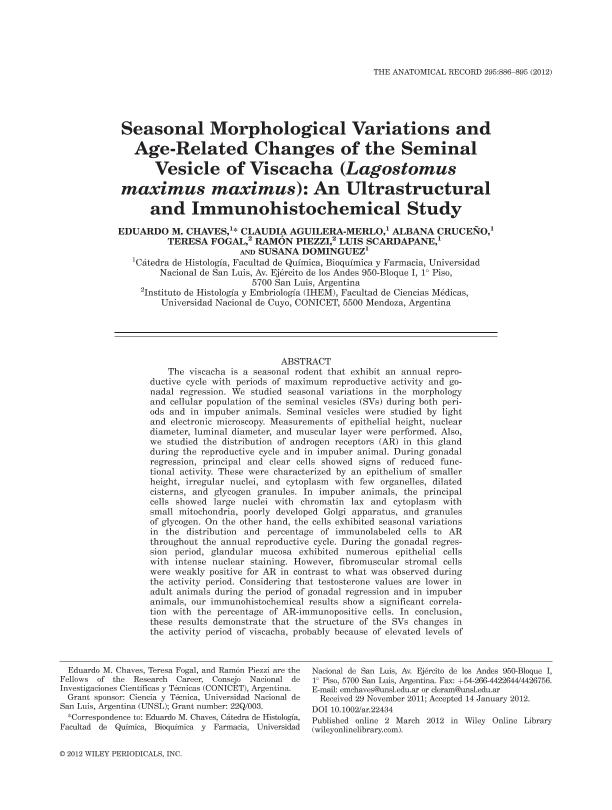Mostrar el registro sencillo del ítem
dc.contributor.author
Chaves, Eduardo Maximiliano

dc.contributor.author
Aguilera Merlo, Claudia Isabel

dc.contributor.author
Cruceño, Albana Andrea Marina

dc.contributor.author
Fogal, Teresa Hilda

dc.contributor.author
Piezzi, Ramon Salvador

dc.contributor.author
Scardapane, Luis Antonio

dc.contributor.author
Dominguez, Susana
dc.date.available
2023-10-30T18:21:40Z
dc.date.issued
2012-02
dc.identifier.citation
Chaves, Eduardo Maximiliano; Aguilera Merlo, Claudia Isabel; Cruceño, Albana Andrea Marina; Fogal, Teresa Hilda; Piezzi, Ramon Salvador; et al.; Seasonal Morphological Variations and Age-Related Changes of the Seminal Vesicle of Viscacha (Lagostomus maximus maximus): An Ultrastructural and Immunohistochemical Study; Wiley-liss, div John Wiley & Sons Inc.; Anatomical Record-Advances in Integrative Anatomy and Evolutionary Biology; 295; 5; 2-2012; 886-895
dc.identifier.issn
1932-8486
dc.identifier.uri
http://hdl.handle.net/11336/216461
dc.description.abstract
The viscacha is a seasonal rodent that exhibit an annual reproductive cycle with periods of maximum reproductive activity and gonadal regression. We studied seasonal variations in the morphology and cellular population of the seminal vesicles (SVs) during both periods and in impuber animals. Seminal vesicles were studied by light and electronic microscopy. Measurements of epithelial height, nuclear diameter, luminal diameter, and muscular layer were performed. Also, we studied the distribution of androgen receptors (AR) in this gland during the reproductive cycle and in impuber animal. During gonadal regression, principal and clear cells showed signs of reduced functional activity. These were characterized by an epithelium of smaller height, irregular nuclei, and cytoplasm with few organelles, dilated cisterns, and glycogen granules. In impuber animals, the principal cells showed large nuclei with chromatin lax and cytoplasm with small mitochondria, poorly developed Golgi apparatus, and granules of glycogen. On the other hand, the cells exhibited seasonal variations in the distribution and percentage of immunolabeled cells to AR throughout the annual reproductive cycle. During the gonadal regression period, glandular mucosa exhibited numerous epithelial cells with intense nuclear staining. However, fibromuscular stromal cells were weakly positive for AR in contrast to what was observed during the activity period. Considering that testosterone values are lower in adult animals during the period of gonadal regression and in impuber animals, our immunohistochemical results show a significant correlation with the percentage of AR-immunopositive cells. In conclusion, these results demonstrate that the structure of the SVs changes in the activity period of viscacha, probably because of elevated levels of testosterone leading to an increase in the secretory activity of epithelial cells.
dc.format
application/pdf
dc.language.iso
eng
dc.publisher
Wiley-liss, div John Wiley & Sons Inc.

dc.rights
info:eu-repo/semantics/openAccess
dc.rights.uri
https://creativecommons.org/licenses/by-nc-sa/2.5/ar/
dc.subject
ANDROGEN RECEPTOR
dc.subject
IMPUBER
dc.subject
SEASONAL REPRODUCTION
dc.subject
SEMINAL VESICLES
dc.subject
TESTOSTERONE LEVELS
dc.subject.classification
Biología Reproductiva

dc.subject.classification
Ciencias Biológicas

dc.subject.classification
CIENCIAS NATURALES Y EXACTAS

dc.title
Seasonal Morphological Variations and Age-Related Changes of the Seminal Vesicle of Viscacha (Lagostomus maximus maximus): An Ultrastructural and Immunohistochemical Study
dc.type
info:eu-repo/semantics/article
dc.type
info:ar-repo/semantics/artículo
dc.type
info:eu-repo/semantics/publishedVersion
dc.date.updated
2023-06-05T12:00:11Z
dc.journal.volume
295
dc.journal.number
5
dc.journal.pagination
886-895
dc.journal.pais
Estados Unidos

dc.journal.ciudad
Nueva York
dc.description.fil
Fil: Chaves, Eduardo Maximiliano. Consejo Nacional de Investigaciones Científicas y Técnicas; Argentina. Universidad Nacional de San Luis. Facultad de Química, Bioquímica y Farmacia; Argentina
dc.description.fil
Fil: Aguilera Merlo, Claudia Isabel. Universidad Nacional de San Luis. Facultad de Química, Bioquímica y Farmacia; Argentina
dc.description.fil
Fil: Cruceño, Albana Andrea Marina. Universidad Nacional de San Luis. Facultad de Química, Bioquímica y Farmacia; Argentina
dc.description.fil
Fil: Fogal, Teresa Hilda. Consejo Nacional de Investigaciones Científicas y Técnicas. Centro Científico Tecnológico Conicet - Mendoza. Instituto de Histología y Embriología de Mendoza Dr. Mario H. Burgos. Universidad Nacional de Cuyo. Facultad de Ciencias Médicas. Instituto de Histología y Embriología de Mendoza Dr. Mario H. Burgos; Argentina
dc.description.fil
Fil: Piezzi, Ramon Salvador. Consejo Nacional de Investigaciones Científicas y Técnicas. Centro Científico Tecnológico Conicet - Mendoza. Instituto de Histología y Embriología de Mendoza Dr. Mario H. Burgos. Universidad Nacional de Cuyo. Facultad de Ciencias Médicas. Instituto de Histología y Embriología de Mendoza Dr. Mario H. Burgos; Argentina
dc.description.fil
Fil: Scardapane, Luis Antonio. Universidad Nacional de San Luis. Facultad de Química, Bioquímica y Farmacia; Argentina
dc.description.fil
Fil: Dominguez, Susana. Universidad Nacional de San Luis. Facultad de Química, Bioquímica y Farmacia; Argentina
dc.journal.title
Anatomical Record-Advances in Integrative Anatomy and Evolutionary Biology

dc.relation.alternativeid
info:eu-repo/semantics/altIdentifier/url/https://anatomypubs.onlinelibrary.wiley.com/doi/full/10.1002/ar.22434
dc.relation.alternativeid
info:eu-repo/semantics/altIdentifier/doi/http://dx.doi.org/10.1002/ar.22434
Archivos asociados
